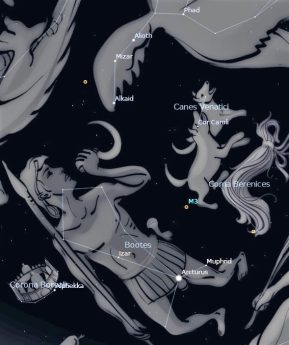This Week’s Sky at a Glance, 2025 Mar 22 – Mar 29
This Week’s Sky at a Glance, 2025 Mar 22 – Mar 29
The spring star is springing up in the east these evenings. Arcturus is the fourth brightest star in the sky and the second brightest we can see from New Brunswick. It is a tad brighter than Vega, the summer star, which rises around 10 pm this week. The winter star, Sirius, sets after midnight and Capella, the autumn star, never sets in southern New Brunswick.
Arcturus anchors the constellation Boötes the Herdsman and the star’s name means “bear driver.” Boötes is seen chasing the two bears, Ursa Major and Ursa Minor, around the celestial North Pole. To many people the constellation resembles a tie, a kite or an ice cream cone. The head of the herdsman, at the tip of the constellation opposite Arcturus, is the star Nekkar, which sounds somewhat like necktie.
Halfway between Arcturus and the hind leg of Ursa Major is the star Cor Coroli in Canes Venatici the Hunting Dogs. Use binoculars to look for a fuzzy patch halfway between Arcturus and Cor Caroli. This is a globular cluster called M3, the third entry in Charles Messier’s 18th century catalogue of things that resemble a comet but aren’t. This cluster contains half a million stars at a distance of 34,000 light years, nearly a thousand times farther than Arcturus.
This Week in the Solar System
Saturday’s sunrise in Moncton is at 7:17 and sunset will occur at 7:34, giving 12 hours, 17 minutes of daylight (7:22 and 7:39 in Saint John). Next Saturday the Sun will rise at 7:04 and set at 7:44, giving 12 hours, 40 minutes of daylight (7:09 and 7:48 in Saint John). When the Sun rises on Saturday, March 29, it will be smiling at us in a deep eclipse that lasts for another hour. Dig out the eclipse glasses that you saved last year and make sure they are not punctured or deeply scratched before using them.
The Moon is at third quarter this Saturday and it will be just past its ascending node when it rises new in front of the Sun next Saturday. Jupiter is at the same altitude as orange Betelgeuse to its left in early evening, hanging above the V-shaped Hyades cluster. Mars continues to flatten the triangle it makes with Pollux and Castor over the week. Venus reaches inferior conjunction this Saturday, followed by Mercury on Monday, and between those days Saturn’s rings appear edge-on. This occurs every 15 years but now it is too close to the Sun for us to not see them. Rural observers might see the faint wedge of the zodiacal light angling up toward the Pleiades 60 to 90 minutes after sunset.
Tune in to the Sunday Night Astronomy Show at 8 pm on the YouTube channel and Facebook page of Astronomy by the Bay.

